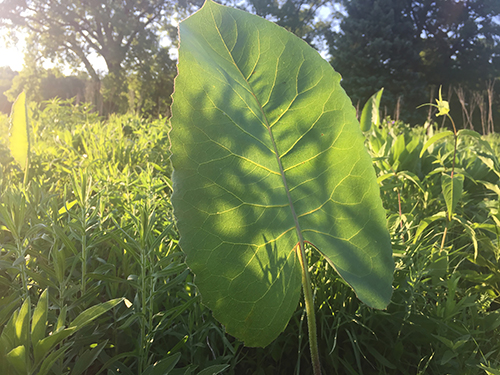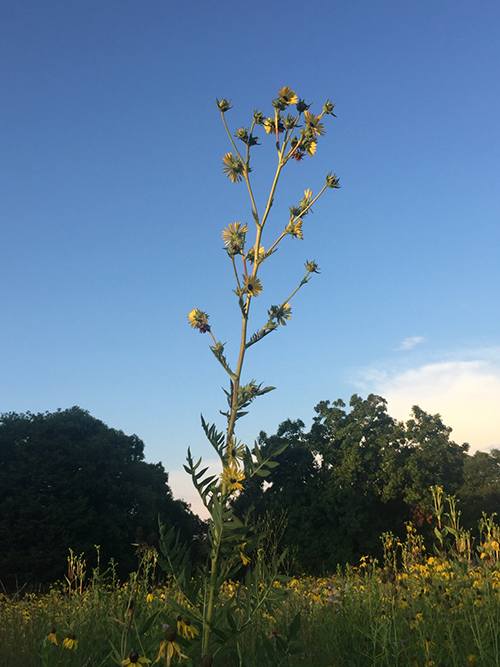
Prairie Dock has some of the largest leaves of all prairie plants. The species can grow up to 10 feet. Flowers bloom by mid- to late-July. This photo was taken at the Tawny Oaks restoration site, part of the Peoria Park District. (PHOTO BY MIKE MILLER)

MIKE MILLER
July is the time of year when the tallgrass prairie becomes spectacular. Unfortunately, many of us will live our entire lives in the “Prairie State” without ever seeing a native tallgrass prairie. According to the Illinois Natural History Survey, in 1820, there were over 22 million acres of land in Illinois that were prairie. By 1978, there were only 2,300 acres of high-quality prairie left.
If you know where to look, there are still several local examples of both native prairie and prairie restorations. Locally, both Forest Park Nature Center and Tawny Oaks have some good prairie restorations, while Robinson Park and Singing Woods Nature Preserve have some great examples of native hill-prairie habitat. Brimfield Railroad Prairie, an Illinois Nature Preserve owned by Peoria Audubon, is a native tallgrass prairie remnant that survived the plow along an abandoned section of railroad right-of-way.
There is a group of prairie plants that everyone should get to know. They typify everything that is spectacular and unique to the prairie experience. I call them the titans of the prairie. A more disciplined botanist would call them members of the genus Silphium in the sunflower family. There are four species that are found regularly in both native prairie remnants and prairie restorations. They include Prairie Dock (Silphium terebinthinaceum), Compass Plant (Silphium laciniatum), Cup Plant (Silphium perfoliatum) and Rosin Weed (Silphium integrifolium).
All of these species have some common characteristics. They have showy yellow flowers. They have leaves that feel as rough as sandpaper. This protects the internal plant tissues from the harsh conditions of growing in the full sun of the tallgrass prairie. They all have deep roots that can grow to several inches in diameter and dive down 16 feet into the deep prairie soils to seek out moisture. Beyond the things they have in common, each species of Silphium has created its own niche in the prairie. Each species has characteristics that make it easy to tell apart from the others.
Prairie Dock has some of the largest leaves in the prairie. The arrowhead-shaped leaves can be over two feet in length. They all grow at the base of the plant and stand amongst the prairie plants like ancient shields. In mid- to late-July, they send up a flower stalk. This smooth, slender stalk will reach for the sky and grow some 10 feet before it branches out to create a cluster of yellow sunflower-like blooms that can be over an inch across.
The Compass Plant has a similar growing pattern in that it has a majority of its large leaves at the base, and sends up a flower stalk. However, its leaves are deeply lobed, resembling a huge dandelion leaf, and have the habit of orienting themselves so the edges point north and south. Hence the name “compass” plant. By arranging their leaves this way, they are assured to capture both morning and afternoon sun. The flower stalk is thick and has some leaves along its 10-foot length. The large yellow flowers grow along the length of the stem.
Cup Plant looks more like a proper sunflower. A thick squarish stem grows from the earth and, along its length, the leaves grow around the stem to form a cup-like structure. These cup-like structures actually hold rainwater and create a tiny oasis for animals. It is very common to see birds and even amphibians taking advantage of the water. The plants can grow over 8 feet in height and the top of the plant is adorned with numerous yellow, sunflower-like blooms.
Rosin Weed is the most diminutive of the Silphium species. Even so, in a moist prairie, they can reach from 4- to 6-feet in height with their leaves arranged opposite of each other along the entire length of the stem. The plant is topped with a single yellow bloom, instead of the multi-bloomed flower head of its cousins. As its name suggests, the plant is rich with a resinous sap that can sometimes be evident in dried deposits along the stem. This gum-like sap is the reason the genus is called “Silphium” This is a Greek word for a North African plant that had similar characteristics.
These titans of the prairie are some of the tallest flowering species that grow in these sun-drenched habitats. July is the perfect time of year to search out and learn these species. With their deep root systems and long life, it is quite possible that a compass plant you see today, was around tickling the bellies of bison in the prairie long before Illinois was a state.

The Compass Plant is a stalwart of the tallgrass prairie. Its roots can reach 16 feet deep.This is one of the signature species at the prairie restoration at Tawny Oaks. (PHOTO BY MIKE MILLER)

Recent Comments